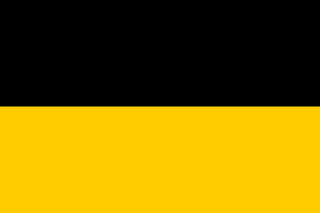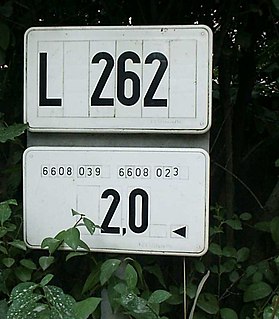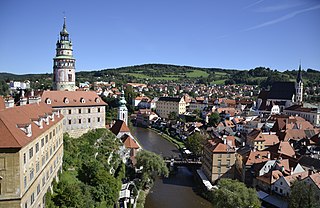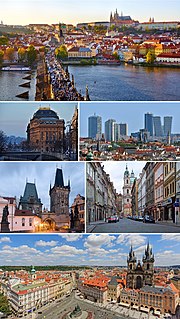
Bohemia is the westernmost and largest historical region of the Czech lands in the present-day Czech Republic. In a broader meaning, Bohemia sometimes refers to the entire Czech territory, including Moravia and Czech Silesia, especially in a historical context, such as the Lands of the Bohemian Crown ruled by Bohemian kings.

Moravia is a historical region in the Czech Republic and one of the historical Czech lands, together with Bohemia and Czech Silesia. The medieval and early modern Margraviate of Moravia was a crown land of the Lands of the Bohemian Crown, an imperial state of the Holy Roman Empire, later a crown land of the Austrian Empire and briefly also one of 17 former crown lands of the Cisleithanian part of the Austro-Hungarian Empire from 1867 to 1918. During the early 20th century, Moravia was one of the five lands of Czechoslovakia from 1918 to 1928; it was then merged with Czech Silesia, and eventually dissolved by abolition of the land system in 1949.

The Sudetenland is the historical German name for the northern, southern, and western areas of former Czechoslovakia which were inhabited primarily by Sudeten Germans. These German speakers had predominated in the border districts of Bohemia, Moravia, and Czech Silesia from the time of the Austrian Empire.

Karlovy Vary or Carlsbad is a spa town situated in western Bohemia, Czech Republic, on the confluence of the rivers Ohře and Teplá, approximately 130 km (81 mi) west of Prague (Praha). It is named after Charles IV, Holy Roman Emperor and King of Bohemia, who founded the city in 1370. It is the site of numerous hot springs, and is the most visited spa town in the Czech Republic.
The German-speaking population in the interwar Czechoslovak Republic, 23.3% of the population at the 1921 census, is usually reduced to the Sudeten Germans, but actually there were linguistic enclaves elsewhere in Czechoslovakia, and among the German-speaking urban dwellers there were "ethnic Germans" and/or Austrians as well as German-speaking Jews. 14% of the Czechoslovak Jews considered themselves as Germans at the 1921 census, but a much higher percentage declared German as their colloquial tongue during the last censuses under the Austro-Hungarian Empire.
The German occupation of Czechoslovakia (1938–1945) began with the German annexation of Czechoslovakia's border regions known collectively as the Sudetenland, under terms outlined by the Munich Agreement. German leader Adolf Hitler's pretext for this action was the alleged privations suffered by the ethnic German population living in those regions. New and extensive Czechoslovak border fortifications were also located in the same area.
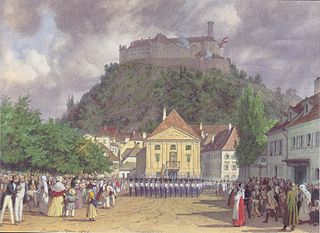
The Congress of Laibach was a conference of the allied sovereigns or their representatives, held in 1821 as part of the Concert of Europe, which was the decided attempt of the Great Powers to settle international problems after the Napoleonic Wars through discussion and collective weight rather than on the battlefield. A result of the Congress was the authorization of Austrian intervention in the Kingdom of the Two Sicilies in order to quell a liberal uprising.

Mikulov is a town in the Moravia, South Moravian Region of the Czech Republic.
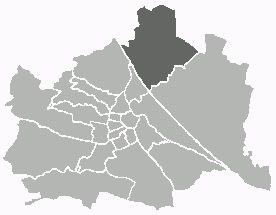
Floridsdorf is the 21st district of Vienna, located in the northern part of the city and comprising seven formerly independent communities: Floridsdorf, Donaufeld, Greater Jedlersdorf, Jedlesee, Leopoldau, Stammersdorf, and Strebersdorf.

The Emperor Ferdinand Northern Railway was the name of a former railway company during the time of the Austrian Empire. Its main line was intended to connect Vienna with the salt mines in Bochnia near Kraków (Krakau). The term is still used today in referring to a number of railway lines formerly operated by that company.

The Přemyslid dynasty or House of Přemyslid was a Czech royal dynasty which reigned in the Duchy of Bohemia and later Kingdom of Bohemia and Margraviate of Moravia, as well as in parts of Poland, Hungary, and Austria.
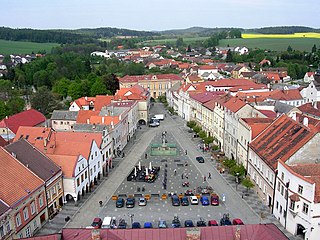
Slavonice is a town situated in the southwest of Moravia near the border with South Bohemia, Czech Republic, about a kilometre from the Austrian border, with about 2,700 inhabitants. While historically the town belongs to Moravia, it is now part of the South Bohemian Region.

Vienna has an extensive transport system that includes motorways, railways and public transport.

The Bundesstraße 5 is a German federal highway running in a northwesterly to southeasterly direction from the Danish border near Niebüll to Frankfurt (Oder). It provides a direct route for motorists traveling between Berlin and Hamburg. In Berlin B5 forms among others the following squares and streets Heerstraße, Theodor-Heuss-Platz, Kaiserdamm, Straße des 17. Juni, Großer Stern, Unter den Linden, Karl-Liebknecht-Straße, Alexanderplatz, Karl-Marx-Allee, Frankfurter Tor, and Frankfurter Allee. The section north of Hamburg is partially paralleled by Bundesautobahn 23.
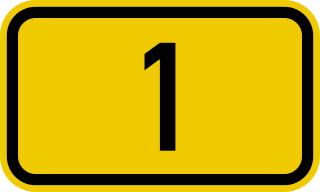
The Bundesstraße 1 is a German federal highway running in an east-west direction from the Dutch border near Aachen to the Polish border at Küstrin-Kietz on the Oder River.

The Bundesstraße 96 is a federal highway in Germany. It begins in Zittau in Saxony, close to the border triangle between Germany, Poland, and the Czech Republic, heads north through Berlin and ends in Sassnitz on the island of Rügen in the Baltic Sea. Some sections of B 96 form a part of the European route E22.

Austria – Czech Republic relations are the neighborly relations between Austria and the Czech Republic, two member states of the European Union.

Bundesstraße 23 is a German federal highway in Bavaria that runs from Peiting to the Austrian border near Garmisch-Partenkirchen. The road is partially a part of the “German Alpine Road”. The B 23 which together with the Bundesstraße 17 and Bundesstraße 472 the quickest way from Augsburg to Garmisch-Partenkirchen, continue along the Bundesstraße 2 to Mittenwald, Innsbruck and the Brenner Pass.

The Bundesstraße 15 is a federal highway in Germany. It is located entirely within the state of Bavaria, runs in an almost perfect north-south direction, and runs from the A 9 north of Hof to the Inntal.

